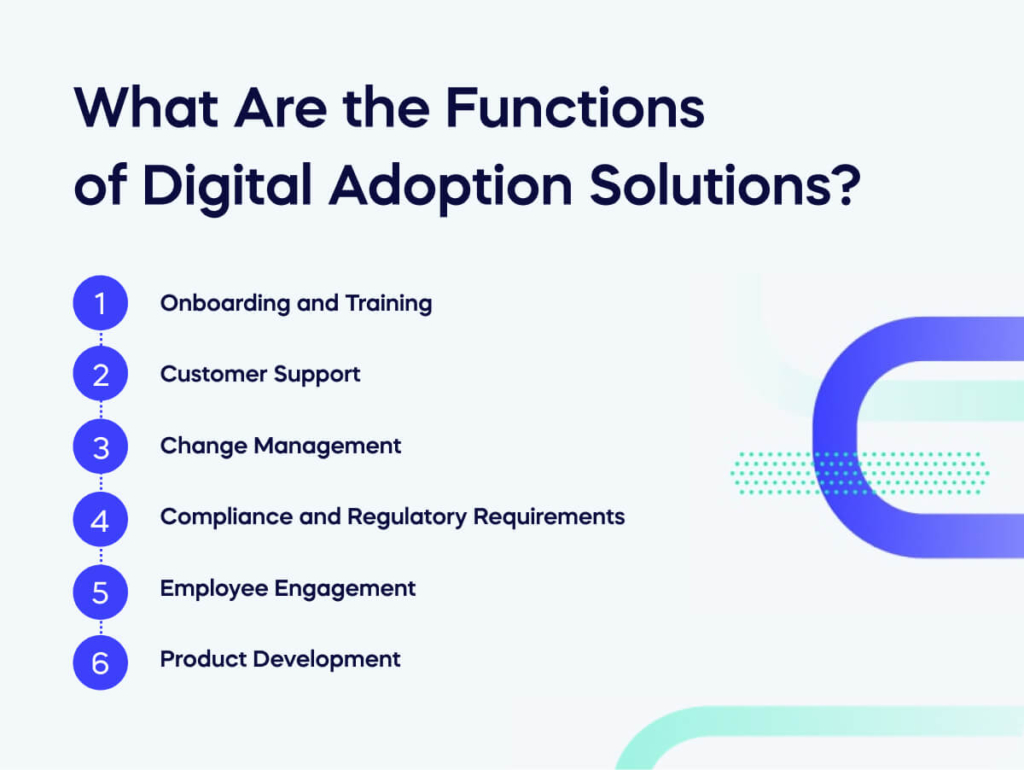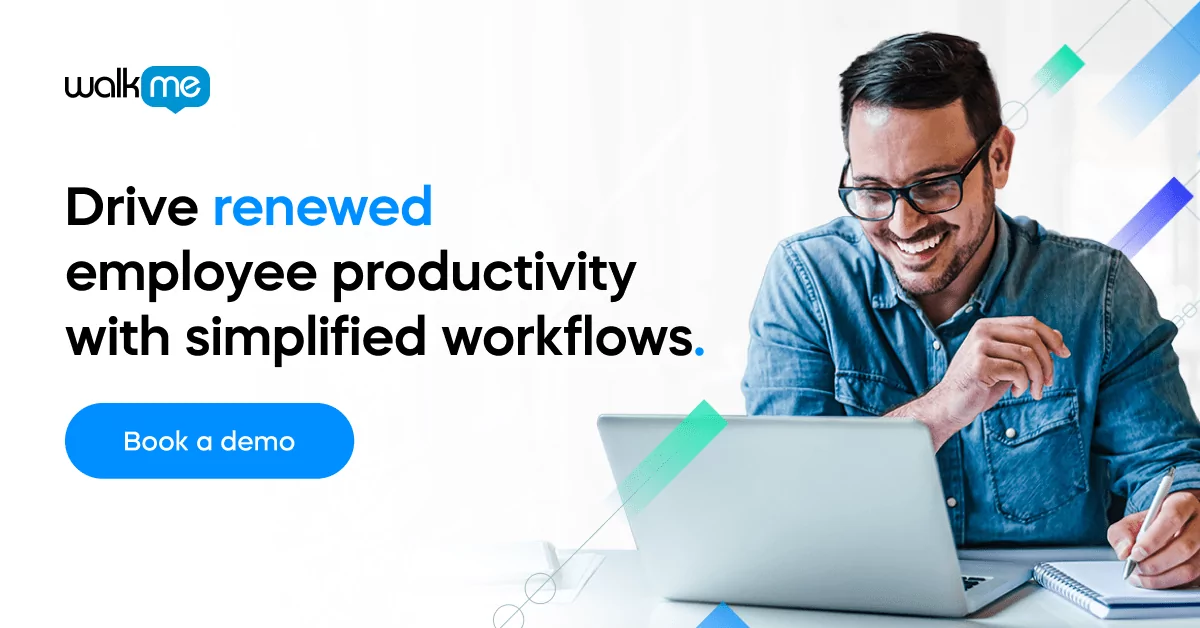Gartner officially recognized digital adoption solutions (DAS) as a new business software category in 2019. According to Gartner’s report “Increase Sales Productivity with Digital Adoption Solutions,” DAS is highly beneficial for increasing the adoption of new technology.
Looking ahead to 2023, digital adoption solutions will be more important than ever. Organizations will continue to rely on DAS technology to drive user adoption and ensure success in digital transformation strategies.
Digital adoption solutions can help organizations improve the adoption of new digital tools and technologies, leading to increased productivity, reduced training costs, improved employee retention, and enhanced customer experience.
And according to a recent report by Gartner, implementing the right (DAS) can enhance employee productivity, engagement, and usage, which brings home the importance of a digital strategy inclusive of digital adoption solutions.
However, some organizations fail to realize the importance of investing in digital adoption solutions. This is often because they lack the resources, budget, or expertise to manage an effective digital adoption strategy.
Fortunately, various options are available that make digital adoption solutions (DAS) more accessible. For one, investing in a Digital Adoption Platform (DAP) is an effective way to ensure your organization stays current with the most recent technologies and training materials.
This article will cover the advantages of utilizing digital adoption solutions and various types of solutions that are accessible while also providing some tips on how to choose the right digital adoption solution for your organization in 2023 and beyond.
What are digital adoption solutions?
Digital adoption solutions (DAS) are software that helps organizations improve the adoption of new digital tools and technologies. They can onboard new employees, train existing employees on new software, and support users struggling to use new technologies.
Different digital adoption solutions are available, each with features and benefits.
Some of the most common features of digital adoption solutions include:
- Onboarding: Digital adoption solutions can help organizations onboard new employees by providing a comprehensive overview of the company’s new digital tools and technologies. This can help new employees get up to speed quickly and easily, so they can start contributing to the company immediately.
- Training: Digital adoption solutions can also train existing employees on new software. This can be done through various methods, such as interactive tutorials, video demonstrations, and quizzes.
- Support: Digital adoption solutions can also provide support for users who are struggling to use new technologies. This can be done through various methods like live chat, email, and phone support.
Digital adoption solutions can be a valuable tool for organizations looking to improve by adopting new digital tools and technologies.
Importance of Digital Adoption Solutions
Digital adoption solutions are essential for businesses to stay ahead in today’s digital age. With the rapid technological advancements, many companies struggle to keep up with the latest trends and updates. Digital adoption solutions offer businesses an easy way to integrate new technologies into their operations and improve overall efficiency.
By incorporating digital solutions, companies can simplify operations, mechanize tasks, and decrease expenses. This, in turn, increases productivity and allows businesses to focus on growth and expansion. Digital adoption solutions also enable companies to provide better customer experiences by leveraging data and analytics to personalize interactions.
Overall, digital adoption solutions give businesses an edge over their competitors as they can promptly adapt to market fluctuations and meet customer needs. Companies that fail to embrace digital solutions risk being left behind by competitors who have embraced the latest technologies.
The benefits of using digital adoption solutions

In today’s rapidly advancing technological landscape, businesses must adapt to stay competitive and thrive. Companies that embrace digital transformation are better equipped to meet the needs of their customers, streamline their workflows, and increase their bottom line.
However, transitioning to a fully digital environment can be challenging, especially for those unfamiliar with the latest technologies. That’s where digital adoption solutions come in.
Below, we will examine the different benefits these solutions provide to assist organizations in achieving successful digital transformations.
- Increased productivity: Digital adoption solutions can help employees get up to speed quickly and easily on new software, leading to increased productivity.
- Reduced training costs: Digital adoption solutions can help organizations reduce the cost of training employees on new software.
- Improved employee satisfaction: Digital adoption solutions can help employees feel more confident and comfortable using new software, improving employee satisfaction.
- Enhanced customer experience: Digital adoption solutions can help organizations improve customer experience by ensuring employees can use new software to provide excellent customer service.
If you are looking for a way to improve the adoption of new digital tools and technologies in your organization, then a digital adoption solution may be a good option for you.
What Are the Functions of Digital Adoption Solutions?

Gartner states that digital adoption solutions primarily aid in sales enablement. Although businesses often invest in CRM systems to assist their sales teams in managing customer relationships and leads, around one-third of these implementations fail due to low adoption rates.
Companies use DAS in addition to their CRM platform to avoid or overcome low adoption rates among their sales representatives. Besides sales, digital adoption solutions can be used in many other scenarios. Such functions may include:
- Onboarding and Training – Digital adoption solutions enable organizations to save time and money on training costs by helping new employees learn their job quickly and efficiently, no matter where they’re located.
- Customer Support – Digital adoption solutions can help customer support teams provide better service by guiding customers through complex processes or troubleshooting steps, reducing the need for human intervention.
- Change Management – Using digital adoption solutions can simplify change management initiatives and help employees embrace new systems, processes, and work methods.
- Compliance and Regulatory Requirements – By offering employees step-by-step guidance and ensuring they comply with correct procedures, digital adoption solutions can aid organizations in meeting intricate regulations.
- Employee Engagement – Improve employee engagement by offering them customized learning paths, including interactive content and gamification features that help them stay motivated and engaged.
- Product Development – Product designers and developers can receive instant feedback on how users interact with their products, which can help them make timely and effective improvements to their design and development processes.
How Do Digital Adoption Solutions Increase Sales Productivity?
In a world where digital transformation is rapidly reshaping the business landscape, sales productivity has become more critical than ever before.
To stay competitive and thrive, companies must embrace technology and leverage digital tools that increase efficiency and accelerate growth. Digital adoption solutions are one such tool that can significantly impact sales productivity.
These solutions can give your business a powerful edge in the marketplace by automating mundane tasks, streamlining workflows, and empowering sales teams with real-time insights.
Digital adoption solutions can enhance sales productivity in multiple ways:
- By implementing DAS (Digital Adoption Solutions) in various applications, users can access guidance and self-help materials seamlessly, regardless of the app they use. This results in a simpler training process, allowing employees to quickly become skilled with the application.
- Employees can receive self-paced training by accessing guided walkthroughs and training materials as needed, enabling them to learn at their own pace.
- With self-help menus available, employees can quickly find solutions to their queries without waiting for customer support, thereby reducing lost productivity.
- DAS analytics can help you identify areas where sales reps are facing challenges while using the app, leading to reduced productivity. Addressing these issues promptly using usage analytics enables you to update training materials to prevent similar issues from arising.
Lack of digital adoption is keeping you stagnant
Many organizations see their digital transformation efforts fail because of a lack of digital adoption. This critical deficiency in the digital era will severely cap your potential to improve internal operations and the customer experience.
Unless people can use technology as intended and with the full range of capabilities, it will be impossible to fully integrate it into the workflow. Not only that, but digital tools will become a barrier to productivity and innovation instead of an enabler.
Without digital adoption, there is no digital transformation success (or progress, for that matter).
Instead, you’ll keep running in place.
Why has this issue gone undetermined for so long?
Digital adoption is an obvious lynchpin for digital transformation. After all, if your users literally can’t use your technology, there’s no way you can achieve any ROI or fulfill your digital strategy.
But, when you’re in the throes of planning, it’s easy to overlook the factors that ultimately contribute to (or prevent) digital adoption.
First, you identify a need to boost your digital arsenal. You create a digital strategy and incorporate it into the business model. You choose cutting-edge technology to make it happen, then dive into implementation.
But then…Few employees actually use the technology and the ones that do stick to a small range of elementary features.
Complex business processes lead many to drop off before completing a task.
Demand for IT support becomes unmanageable.
User frustration and stress cause a serious blow to employee morale.
The tools that were supposed to lift employee productivity to new heights are becoming barriers to completing everyday work.
A lack of digital adoption is to blame for all of these issues. It’s just hard to pinpoint amid broad digital change. But with a clear definition, we have a common language to understand the problem.
A Digital Adoption Solution is the missing link
The builders of WalkMe understood the impact of digital adoption years ago. As more and more organizations arrive at the same realization, the demand for a solution is rising.
In a nutshell: What does a digital adoption solution do?
A digital adoption solution is a tool that addresses all of the factors that prevent users from adopting technology, such as inadequate training, complex user interfaces, frequent updates from the cloud, and many more.
This breed of software guides users through business processes on any enterprise platform, app, or website, enabling even first-time users to complete any task efficiently.
Its on-screen, real-time guidance eliminates investing in lengthy (and ineffective) traditional training modes. It ensures users always have access to support, even if they forget how to do something.
Digital adoption solutions are invaluable to any digital growth initiative. They save organizations time and money with greater productivity and faster user time-to-competency, provide analytics to continuously improve the user journey, and strengthen both the employee and customer experience.
WalkMe’s DAP: Leader of the pack
While digital adoption solutions are just recently recognized as an official category of technology, WalkMe has been building and refining its Digital Adoption Platform (DAP) for nearly a decade.
Here’s what the pioneer of digital adoption solutions does.
Provide training that actually works
The truth is traditional training methods are not equipped to prepare employees for the modern digital workplace. Classroom learning sessions, webinars, or training manuals are time-consuming, take employees away from their work, and lead to poor knowledge retention.
Instead, digital solutions that enable contextual learning allow employees to get up to speed instantly. The DAP ensures all users, regardless of prior software experience, can easily navigate and use the full range of features.
By analyzing a broad range of contextual factors (such as a user’s position, the task at hand, prior user behavior, the goals of the department, etc.), the DAP provides proactive guidance and literally walks the user through any process step-by-step.
This completely eliminates the need for traditional training. Instead, users “learn in the flow of work” and can be productive from the first time they use a software or app.
Optimize any business process
Many organizations are unaware of the toll time-consuming and complex digital processes impose. When key business processes aren’t user-friendly, productivity, accuracy, and efficiency are all at risk.
According to one of our studies, if business processes require too many steps or take too long, employees are likely to “drop off” or quit in the middle. This means people are either not finishing their tasks or finding an unsanctioned workaround.
The study found that if a digital business process takes more than two minutes, 50% of users will drop off. And only processes that have five or fewer steps have a 70% success rate. Anything more than that will drive users to quit.
The DAP empowers you to optimize any digital process with automation. Among WalkMe customers who used business process automation, the process completion rate was 81%, compared to 49% for those that didn’t use automation.
Provide a superior customer experience
The DAP empowers you to provide an enhanced customer experience via two main avenues.
The first opportunity is to integrate the solution on consumer-facing platforms. For example, if a consumer visits a retail website with the intention of buying something, on-screen navigational guidance will ensure they can find exactly what they’re looking for in the least possible steps.
It fulfills consumers’ desire for access to information, expediency, and a seamless experience.
The second way the DAP can improve CX is by empowering employees to better serve customers. If employees are burdened by complex software that is difficult to use and interferes with customer interactions, there’s no way they can provide an engaging experience.
By making employees’ lives easier, taking over mundane tasks via automation, and ensuring accuracy, the DAP increases employee efficiency and gives them the power to provide the best possible experience.
Find your missing link
It’s easy to get on the track to digital transformation success when you can identify exactly what has been holding you back.
Without digital adoption, there is no way to fulfill your digital strategy. The establishment of the new category reconfirms what we already know is an essential truth in the digital era: human users need real-time, personalized support to exploit technology’s full potential.
What’s next for digital adoption solutions?
Digital Adoption Solutions (DAS) are expected to continue playing a critical role in ensuring successful digital transformation for businesses. As technology evolves rapidly post-pandemic, DAS will be essential for ensuring employees are up-to-date on the latest software and applications.
One of the key features that we can expect to see in the future of DAS is an increased focus on automation. By automating certain aspects of the digital adoption process, companies can reduce the burden on employees and increase efficiency. This includes automated onboarding, contextual guidance, and real-time support.
Another trend likely to emerge is integrating augmented reality (AR) and virtual reality (VR) technologies into DAS. These immersive technologies can provide users with an engaging and interactive experience, helping them better understand complex processes and systems.
Finally, we expect more advanced analytics and reporting capabilities in DAS. This will enable companies to track user progress, identify areas for improvement, and measure the ROI of their digital transformation efforts.


